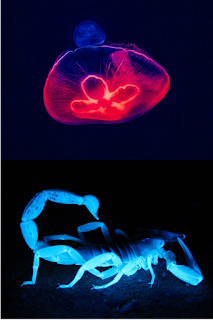 |
Luminescent (top) & Fluorescent animals
|
In
Part IV of our All About Color series (June 28, 2020), we discussed the signals exchanged between male fireflies and their female glowworms, and talked about sea creatures that generate their own light (bioluminescence); additionally, we examined some organisms (like scorpions) that show surprising colors under ultraviolet light (fluorescence). These are areas of study in which exciting things are happening right now and we would like to point out some of the more interesting discoveries. Some of them have been discovered since that article appeared.
(Underlined items link to recent articles.)
For a long time, it was believed that the vast majority of bioluminescent sea creatures spent part or all of their lives in the deepest, darkest parts of the warmer oceans, although some (jellyfish, comb jellies, and some squid) rose to the surface at night before daylight drove them back to the depths during the day.
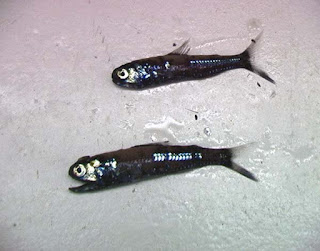 |
| Lanternfish |
As better and better deep sea exploration is done, scientists are seeing more and more sea creatures that glow, either to lure prey into their mouths or to escape predators. Better cameras that can withstand the greater pressures at greater depths showed them some surprising animals glowing right along, in some previously unknown places. For instance, only recently
bioluminescent species were found near the sea floor of even the coldest arctic waters.
Newer, stranger, and larger animals have been found. For example, some squid shoot out a glowing liquid instead of the usual ink in order to confuse predators while the squid escape. There is at least one squid that changes the color of its luminescence to match moonlight and sunlight. Translucent skin allows a high level of transmission of light, especially in the blue-green color range.
At least three species of sharks found off of the coast of New Zealand are known to light up their undersides with a blue-green glow, which makes them difficult to see. These are not the tiny bottom-feeding sharks, either. They are at least six feet long and inhabit the area of the sea from a depth of 200 meters to one of 2000 meters (650’ to 6500’). This range is sometimes called the Twilight Zone and isn’t as dark as the lightless regions previous known species inhabit. As late as 2020 these sharks were believed to be the largest living vertebrates capable of luminescence.
 |
Bioluminescent shark
|
But, wait a minute, what about whale sharks? Whale sharks are huge fish that have skeletons of cartilage instead of bone. They are filter feeders that swim through the water with their huge mouths open, scooping up plankton, fish eggs, and small fish. Well, they aren’t bioluminescent;
but they ARE fluorescent! It turns out that they have blue dots on their backs that glow green when they are in relatively shallow water. The current theory is that they use the dot patterns to communicate with each other so that they can school together in large groups, either for hunting prey or mating. More work needs to be done on this phenomenon.
 |
Whale shark
|
Now it is generally conceded that approximately 3/4 of marine life glows to some degree or other, but we are far from understanding all the ways they accomplish this. Now if we only we had a glowing whale….
When an animal is bio-fluorescent, it is usually because it has taken in a short wavelength of ultraviolet (UV) light and then re-emits it as a longer wavelength of a color from the visible spectrum. There are other ways to do this, but we do not yet really understand them.
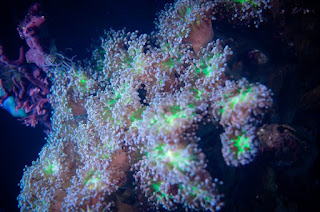 |
Fluorescent coral
|
Scientists have known for a long time that animals that find food and/or shelter on coral reefs adopt colors or patterns that make them hard to see among the coral occupants (
camouflage). However, these creatures themselves can see light wavelengths that we — and the predatory fish that might feed on them — cannot see. This property is known as
bio-fluorescence, and does seem to extend to wavelengths longer than just UV. Most of these animals are relatively small — a few inches long at best. For example, some crustaceans send our light signals when it is mating time. But as scientists began to study such animals, they found larger and larger specimens.
Not so long ago, a supposedly scholarly paper announced that there were no bioluminescent or bio-fluorescent non-flowering plants, amphibians, reptiles, birds, or mammals. Wrong on all counts. The amphibians may take the blue ribbon. Of 32 species of frogs, toads, and salamanders studied in 2020, all 32 showed some ability to glow. In 2017
a fluorescent glow-in-the-dark frog was discovered in Argentina. This polka dot tree frog produces a blue-green pigment that has been determined to be bile produced by its bile ducts. It is not yet known whether the dots serve a specific function, are non-functional, or are structural colors made by layers of clear materials. We discussed structural color
in a previous post.
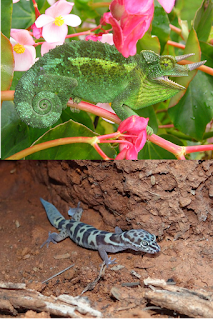 |
Chameleon & Gecko
|
Reptiles are just beginning to be studied for bio-fluorescence. So far chameleons and geckos have been found to glow in the dark. Some have such translucent skin that even their bones are seen to glow. In 2016 researchers looking for fluorescent corals came across a fluorescent sea turtle. Bear in mind that the ancestors of these animals lived as long ago as the dinosaurs. It might tell us something if dinosaur fossil bones and teeth are studied to see if they had any glowing properties. And yes, such properties can sometimes be detected in very old specimens — especially if they were buried soon after death.
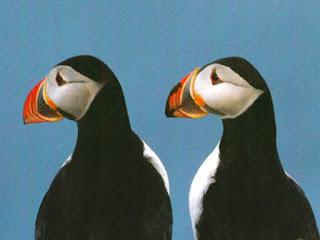 |
Puffins in mating colors
|
Birds may be the hardest to study because they are difficult to track in flight, but we know parakeets, eagles, herons, owls, puffins, and some penguins are already on the list. Some of these birds are nocturnal hunters. Others migrate long distances and rest overnight on land or water. The ability to glow could break up their silhouettes and confuse nighttime hunters. Some, like the puffins, have showy beaks during the mating season and these have glowing parts. Fluorescent bird feathers would likely be significant in mating rituals.
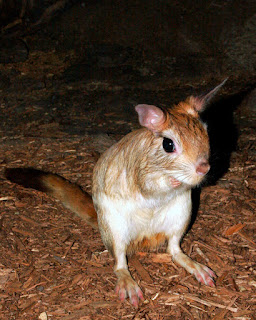 |
| Springhare |
There are already a number of placental mammals on the list and more being found all the time. The numbers indicate that they may be much more widespread than we thought. I wish that I had known that there were three species of flying squirrels (
two of these have undersides that glow pink under black light) here in the U.S. long ago when my sister-in-law was raising them. So far my favorite
glow-in the-dark mammal is the Springhare, a sweet little animal from Africa, very rare — only 2 species are known. It looks like it has a short-eared bunny head on the body of a tiny pouch-less kangaroo.
 |
| Echidna |
The most recent shock was that not only was an unusual animal capable of glowing, but that it may have been doing so for an EXTREMELY long time!The animal is
the platypus, an almost-mammal belonging with the echidna in a group called
monotremes. These animals are members of an ancient group that have warm blood and fur, but lay eggs. Once the babies hatch, a milk-like substance oozes from the parent's body to feed the young. The echidna has a body which is covered with sharp spikes. Examination with an ultra-violet detector shows that when the animal crouches down on its nest those spikes glow a bright white. Not something a predator is likely to put in its mouth!
Next in line come the marsupials whose newborn, while in a very tiny, "unfinished" state, has to crawl up the mother's fur to her pouch and fasten itself to a nipple. Eventually it begins to spend some time outside the pouch, but still returns to it for some months. It had been known for years that the pouched American opossum could glow, but no one cared to investigate further. So it should not have been such a shock to find that the wombat, the bush-tailed possum, the koala, and the bandicoot could glow. Now we can
tentatively add the Tasmanian Devil. Museum specimens may be able to tell us about the extinct Tasmanian Wolf and Tiger.
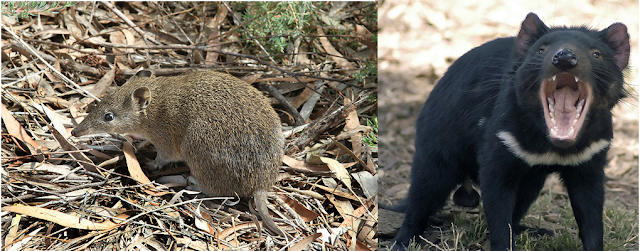 |
Bandicoot & Tasmanian Devil
|
There is enough work here to keep both professionals and amateur scientists busy for years. Yes, you read that correctly. While the search for new bio-luminescent creatures is usually the province of of professionals requiring cutting edge technology, bio-fluorescence needs much simpler and relatively inexpensive equipment and training to find — it seems that until recently, it just hadn’t occurred to anybody to take a serious look at the phenomenon! (And if there isn't a company out there making UV flashlights 24 hours a day, they are missing a trick! This is fun
everyone can get in on!)

 This post by Annake's Garden is licensed under a Creative Commons Attribution-NonCommercial-ShareAlike 3.0 Unported License.
This post by Annake's Garden is licensed under a Creative Commons Attribution-NonCommercial-ShareAlike 3.0 Unported License.









 This post by Annake's Garden is licensed under a Creative Commons Attribution-NonCommercial-ShareAlike 3.0 Unported License.
This post by Annake's Garden is licensed under a Creative Commons Attribution-NonCommercial-ShareAlike 3.0 Unported License.











